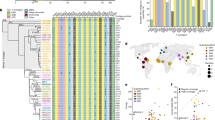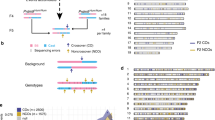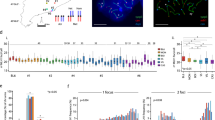Abstract
The pseudoautosomal region (PAR) is a segment of shared homology between the X and Y chromosomes. Here we report physical linkage of three mouse PAR probes: DXYHgul, DXYMov15 and (TTAGGG)n. Steroid sulphatase (Sts) maps distal to these three probes, indicating that there is an internal array of the telomere sequence (TTAGGG)n in the PAR. Pseudoautosomal Pacl restriction fragments, up to 2 Mb in size, are unstable in C57BL/6 × C57BL76 crosses. New alleles, often several hundred kilobases different in size, occur at a sex–averaged rate of ∼30% per allele. Such frequent large–scale germ–line genome rearrangements are without precedent in mammals.
This is a preview of subscription content, access via your institution
Access options
Subscribe to this journal
Receive 12 print issues and online access
$209.00 per year
only $17.42 per issue
Buy this article
- Purchase on Springer Link
- Instant access to full article PDF
Prices may be subject to local taxes which are calculated during checkout
Similar content being viewed by others
References
Hale, D.W. Is X–Y recombination necessary for spermatocyte survival during mammalian spermatogenesis? Cytogenet. Cell Genet. 65, 278–282 (1994).
Ashley, T., Ried, T. & Ward, D.C. Detection of nondisjunction and recombination in meiotic and postmeiotic cells from XYSxr [XY,Tp(Y)1Ct] mice using multicolor fluorescence in situ hybridization. Proc. Natl. Acad. Sci. USA 91, 524–528 (1994).
Rappold, G.A. The pseudoautosomal regions of the human sex chromosomes. Hum. Genet. 92, 315–324 (1993).
Matsuda, Y., Hirobe, T. & Chapman, V.M. Genetic basis of X–Y chromosome dissociation and male sterility in interspecific hybrids. Proc. Nati. Acad. Sci. USA 88, 4850–4854 (1991).
Hale, D.W., Washburn, L.L. & Eicher, E.M. Meiotic abnormalities in hybrid mice of the C57BL/6 × Mus spretus cross suggest a cytogenetic basis for Haldane's rule of hybrid sterility. Cytogenet. Cell Genet. 63, 221–234 (1993).
Matsuda, Y., Imai, H.T., Moriwaki, K., Kondo, K. & Bonhomme, F. X–Y chromosome dissociation in wild derived Mus musculus subspecies, laboratory mice, and their F, hybrids. Cytogenet. Cell Genet. 34, 241–252 (1982).
Kipling, D. et al. Structural variation of the pseudoautosomal region between and within inbred mouse strains. Proc. Natl. Acad. Sci. USA 93, 171–175 (1996).
Harbers, K., Soriano, P., Müller, U. & Jaenisch, R. High frequency of unequal recombination in pseudoautosomal region shown by proviral insertion in transgenic mouse. Nature 324, 682–685 (1986).
Harbers, K., Francke, U., Soriano, P., Jaenisch, R. & Müller, U. Structure and chromosomal mapping of a highly polymorphic repetitive DNA sequence from the pseudoautosomal region of the mouse sex chromosomes. Cytogenet. Cell Genet. 53, 129–133 (1990).
Takahashi, Y. et al. Methylation imprinting was observed of mouse mo-2 macrosatellite on the pseudoautosomal region but not on chromosome 9. Chromosoma 103, 450–458 (1994).
Eicher, E.M. et al. The mouse Y* chromosome involves a complex rearrangement, including interstitial positioning of the pseudoautosomal region. Cytogenet. Cell Genet. 57, 221–230 (1991).
Sefton L., Arnaud, D., Goodfellow, P.N., Simmler, M.-C. & Avner, R. Characterization of the central region containing theX-inactivation center and terminal region of the mouse X chromosome using irradiation and fusion gene transfer hybrids. Mamm. Genome 2, 21–31 (1992).
Matsuda, Y. & Chapman, V.M. Application of fluorescence in situ hybridization in genome analysis of the mouse. Electrophoresis 16, 261–272 (1995).
Eicher, E.M., Lee, B.K., Washburn, L.L., Hale, D.W. & King, T.R. Telomere-related markers for the pseudoautosomal region of the mouse genome. Proc Natl. Acad. Sci. USA 89, 2160–2164 (1992).
Eicher, E.M. & Shown, E.P. Molecular markers that define the distal ends of mouse autosomes 4,13, and 19 and the sex chromosomes. Mamm. Genome 4, 226–229 (1993).
Salido, E.G., Li, X.M., Yen, P.H., Martin, N., Mohandas, T.K. & Shapiro, L.J. Cloning and expression of the mouse pseudoautosomal steroid sulphatase gene (Sts). Nature Genet. 13, 83–86 (1996).
Keitges, E., Rivest, M., Siniscalco, M. & Gartler, S.M. X-linkage of steroid sulphatase in the mouse is evidence for a functional Y-linked allele. Nature 315, 226–227 (1985).
Soriano, P. et al. High rate of recombination and double crossovers in the mouse pseudoautosomal region during male meiosis. Proc. Natl. Acad. Sci. USA 84, 7218–7220 (1987).
Keitges, E.A., Schorderet, D.F. & Gartler, S.M. Linkage of the steroid sulphatase gene to the sex-reversed mutation in the mouse. Genetics 116, 465–468 (1987).
Nagamine, C.M., Michot, J.-L., Roberts, C., Guénet, J.-L. & Bishop, C.E. Linkage of the murine steroid sulfatase locus, Sfs, to sex reversed, Sxr a genetic and molecular analysis. Nucl. Acids Res. 15, 9227–9238 (1987).
Wilkie, A.O.M. et al. Stable length polymorphism of up to 260 kb at the tip of the short arm of human chromosome 16. Cell 64, 595–606 (1991).
Rugarli, E.I. et al. Different chromosomal localization of the Clcn4 gene in Mus spretus and C57BL/6J mice. Nature Genet. 10, 466–471 (1995).
Meyne, J. et al. Distribution of non-telomeric sites of the (TTAGGG)n telomeric sequence in vertebrate chromosomes. Chromosoma 99, 3–10 (1990).
Yen, C.-H., Matsuda, Y., Chapman, V.M. & Elliott, R.W. A genomic clone containing a telomere array maps near the centromere of mouse Chromosome 6. Mamm. Genome 6, 96–102 (1995).
Elliott, R.W. & Pazik, J. An interstitial telomere array near Hba on mouse Chr 11 is a candidate for the homolog of the telomere at human 16p. Genomics 27, 217–218 (1995).
Cattanach, B.M., Pollard, C.E. & Hawkes, S.G. Sex-reversed mice: XX and XO males. Cytogenetics 10, 318–337 (1971).
Ashley, T., Lieman, J. & Ward, D.C. Multicolor FISH with a telomene repeat and Sry sequences shows that Sxr (Sex reversal) in the mouse is a new type of chromosome rearrangement. Cytogenet. Cell Genet. 71, 217–222 (1995).
Kipling, D. & Cooke, H.J. Hypervariable ultra-long telomeres in mice. Nature 347, 400–402 (1990).
Kipling, D., Ackford, H.E., Taylor, B.A. & Cooke, H.J. Mouse minor satellite DNA genetically maps to the centromere and is physically linked to the proximal telomere. Genomics 11, 235–241 (1991).
Author information
Authors and Affiliations
Corresponding author
Rights and permissions
About this article
Cite this article
Kipling, D., Salido, E., Shapiro, L. et al. High frequency de novo alterations in the long–range genomic structure of the mouse pseudoautosomal region. Nat Genet 13, 78–82 (1996). https://doi.org/10.1038/ng0596-78
Received:
Accepted:
Issue Date:
DOI: https://doi.org/10.1038/ng0596-78
This article is cited by
-
Ensuring meiotic DNA break formation in the mouse pseudoautosomal region
Nature (2020)
-
A primer on the use of mouse models for identifying direct sex chromosome effects that cause sex differences in non-gonadal tissues
Biology of Sex Differences (2016)
-
A polymorphic pseudoautosomal boundary in the Carica papaya sex chromosomes
Molecular Genetics and Genomics (2015)
-
A pronounced evolutionary shift of the pseudoautosomal region boundary in house mice
Mammalian Genome (2012)
-
Brain Pathways Mediating the Pro-Aggressive Effect of the Steroid Sulfatase (Sts) Gene
Behavior Genetics (2010)



